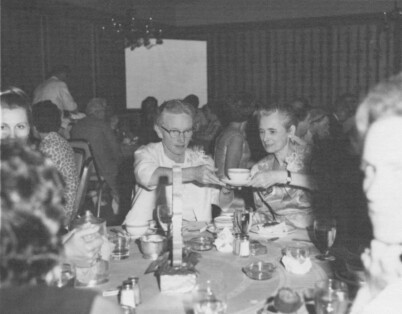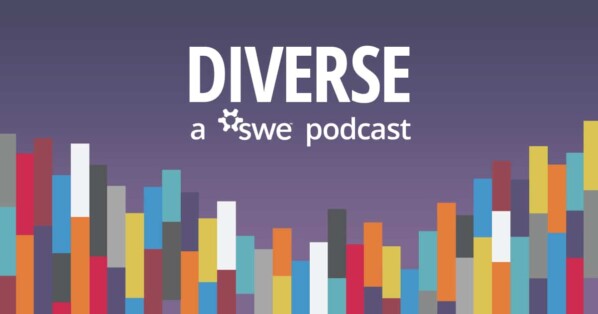Listen to the archived podcast or read the transcript below, then make sure to share it with your colleagues and friends! and be sure to check out our other archives podcasts, as well.

Anne Perusek: Welcome to SWE Stories Tales: From the Archives. I’m Anne Perusek, the Society of Women Engineers’ director of editorial and publications.
Eller English: And I’m Troy Eller English, SWE’s archivist. And I’m very excited because today we are going to share with you an audio recording that I recently rediscovered of a 1968 national convention panel presentation featuring seven past Achievement Award recipients. I first discovered and digitized this recording more than a decade ago, shortly after I became SWE’s archivist, but I was new and I didn’t fully appreciate who the speakers were. I listened to the recording again just before WE19 and, with the hindsight of 12 years, I was astounded by how remarkable this recording is.
Perusek: And the speakers in this 1968 convention panel are truly remarkable. They are 1956 Achievement Award recipient Elise Harmon, 1957 recipient Rebecca Sparling, 1961 recipient Laurel van der Wal Roennau, 1963 recipient and SWE’s founding president Beatrice Hicks, 1964 recipient Grace Murray Hopper, 1965 recipient Martha Thomas, and 1967 recipient Marguerite Rogers.
Eller English: And the moderator of the panel was SWE president Alice Morgan Martin, who asked the past award recipients to speak about what receiving the Achievement Award meant to them and what they had accomplished in the years since.
Perusek: It’s a wonderful recording and very exciting to hear the voices of these distinguished early women engineers, especially SWE’s founding president Bea Hicks, and computer programming pioneer Grace Murray Hopper, speaking about their careers, families, SWE, and the experience of receiving SWE’s Achievement award with great humility and humor.
Eller English: And I will say that the panel begins earnestly and informatively, but about halfway through, while still remaining professional and informative, the panel became something closer to a comedy show. It turns out that Grace Murray Hopper was a very, very funny lady, although I would argue that Martha Thomas and Marguerite Rogers perhaps stole the show at the end with their anecdotes about work-life integration and their witty insights from their careers.
Perusek: Indeed! The panel was great fun, but more than an hour-long, so we’ll be featuring the Achievement Award recipients in three different episodes of Tales from the Archives. In this episode, we feature the first three panelists: Elise Harmon, Rebecca Sparling, and Beatrice Hicks.
Eller English: And careful listeners might have noticed that since she received her Achievement Award two years prior to Beatrice Hicks, chronologically-speaking Laurel van der Wal Roennau should be—but is not—the third panelist in this episode. There’s a story, but you’ll have to listen to find out what it is.
Perusek: Yes. As I mentioned, the first speaker on this 1968 panel, Elise Harmon, who received the SWE Achievement Award in 1956 in recognition of her important innovations in field of component and circuit miniaturization, including devising an engine generator refinement that enabled WWII U.S. fighter planes to fly above 15,000 feet, the micro-miniaturization of printed circuitry components, and developing a new methodology for producing printed circuitry.
Eller English: And I will note that this was recorded on reel-to-reel audio magnetic tape some 52 years ago. I’ve adjusted some frequencies to pull the speakers’ voices out of the murk, but you’ll notice that the audio retains a delightful old-timey quality that we’ll consider a feature, and not a flaw. However, you can follow along in the transcript for this episode, found on alltogether.swe.org. And with that, we’ll begin with 1968 SWE president Alice Martin’s introduction of 1956 Achievement Award recipient Elise Harmon.
[Audio excerpt from 1968 SWE National Convention Achievement Award recipient panel]
Alice Morgan Martin: In 1956, the SWE Achievement Award was conferred upon Miss Elise Harmon, an outstanding physicist and chemist, in recognition of her significant contributions to the area of component and circuit miniature—miniaturization. Woo, that’s a hard one this morning. (laughter) At that time, Elise headed the printed circuit activities of the Aerovox Corporation in New Bedford, Massachusetts, directing the research and development, and establishing the pilot plant procedures for a new method of printed circuitry. She is a graduate of North Texas State College in Denton, Texas, received her master’s degree from the University of Texas, and has studied at George Washington University and the University of Maryland. Elise Harmon holds many patents and has authored numerous technical publications. Her latest honor was the President’s Award, conferred by the Institute of Printed Circuits in March of this year. It is my pleasure to introduce the recipient of the 1956 Achievement Award, Miss Elise Harmon. (applause)
Elise Harmon: Thank you and good morning. Well, it’s indeed a pleasure to be here. However, if you look back to 1956 to have got an award, maybe there weren’t too many of us to choose from. (laughs) And I don’t know whether my accomplishments will compare at all with the people that are getting the award today—or have gotten it last year, or the year before, the year before—because it looks like they’re getting smarter and smarter and smarter every year. So, it’s good that they put me on the program first, so maybe you’ll forget all about it by the time it gets through hearing all the wonderful things that the others have done.
The years 1952 to 1957, I would say, were my best years, because 1956 is the year that I got the award, which was a complete surprise to me. I didn’t even know that there was such an organization as the Society of Women Engineers at that time. But since then, I have definitely known that there was a Society of Women Engineers since I have participated in three of the sections: one in Boston, one in New York, and now the one in L.A. And it has been wonderful years of working with the Society particularly, and I’m proud of the work that we’ve been able to do with the high school and the college students.
1952 to 1957, one reason why it’s so important to me is that it was the first—I had always worked for the government or had been a schoolteacher—and those were the years that I started working for private industry. And that is a new experience, particularly if you’ve been working with the government and then going to private industry. And also, it’s because a private industry had the nerve—this particular one—to hire a woman as director of research and engineering of new products. First woman they had ever hired for any position in that company in the management position. Then also that year, that I was able to develop three new products for the company, and carry them through research and development, to the power production, and finally into full production. And also, I got four patents that year—which I think was pretty hard work.
Working in microminiaturization went back even before 1952, because during the war the proximity fuse was developed, and I was in the development work thereof microminiaturizing—or what we called then, miniaturizing—the amplifier that went into the nose of the VT fuse. That was a piece of hardware—it was about the size of a postage stamp—that had three miniature tubes on it, seventeen capacitors, and eighteen resistors, all in that small piece of hardware.
But after the war, little work was done in miniaturization until the development of our requirements in our space program—particularly in our ICBMs [intercontinental ballistic missiles]. And there again, miniaturization came back to being, and it was then that I went into computer design and computer fabrication work, and worked on the Atlas and the Titan missiles. And microminiaturizing the computer for the purpose of decreasing weight and volume, to make it lighter so that we could fire the missiles further.
Since then, I’ve been working in the field of microminiaturization, as it’s called now—because our components are becoming smaller, and smaller, and smaller. And with the introduction of solid-state, more and more every day, and with the integrated circuitry as they’re being developed today, now I’m working on—have had charge of the development and putting into production the microminiature version of the Minuteman Missile at Omnetics, here in California. And now, we’re working on the third stage—or the third revision—of the miniaturized program for the Minuteman missiles. And it has really been a pleasure for me to work with the Society, and I shall continue to work as long as I’m in the field, and because the Society has certainly done a great, great deal for me. Thank you. (applause)
Martin: Thank you very much, Elise.
[End audio excerpt]
Eller English: It was great to hear Elise Harmon’s description of her work. The next person on the panel was Rebecca Sparling, who received the 1957 Achievement Award for expanding knowledge of metallurgy and space materials engineering and nondestructive testing of metals. And once again she is introduced by Alice Martin.
[Audio excerpt from 1968 SWE National Convention Achievement Award recipient panel]
Martin: In 1957 the judges selected as the winner of the Achievement Award a staff consultant at Convair Corporation, which is now General Dynamics—I hope I’m right on that—in the field of materials and processes. Her name: Mrs. Rebecca Sparling. The award was conferred in recognition of her meritorious contributions to high-temperature metallurgy and non-destructive testing of metals. Through her keen interest in the use of materials in engineering structures, Becky Sparling has expanded engineering knowledge in a very important area.
She graduated and received her master’s degree from Vanderbilt University, and later studied at the Massachusetts Institute of Technology and the University of California in Los Angeles. She is a registered professional engineer in California. Her latest honor was the Los Angeles Engineers Week Achievement Award in 1965. She is married to Joseph Sparling, who is retired after twenty-three years in aerospace work. Her son, Doug, age thirty, is now completing his thesis for a doctorate in computer science at Purdue. Becky Sparling is loved by all who know her. It is with great pleasure that I introduce Mrs. Rebecca Sparling. (applause)
Rebecca Sparling: Thank you Alice and all of my friends out there. Alice asked me when she planned this program if each of us would say something about what winning the award had meant to us. And I think I can certainly say, truthfully, that it was a high spot of my career for several reasons. One is there’s nothing nicer than having people that you know and respect do something nice for you. And this has been a really wonderful occasion.
The other reason is that it opened my eyes to the possibilities for work among younger people—particularly high school girls, and even younger—and telling them about chances in engineering. And this is one thing that I have been extremely interested in, especially since I got the award The next year, after that, I was chairman of the Gilbreth Scholarship committee—the committee that set up the scholarship, and the rules, and selected the first winner. And then a couple of years of ago, I had the pleasure of being chairman of the awards committee. So, I’ve really enjoyed that participation.
Professionally, I am now retired. And I did sort of start retiring in 1964 when I went on half-time and just did consulting work in materials from then on. So, I haven’t been as active or productive in my career as Elise has, but I’m having a wonderful time. (laughter) One of the reasons is that I believe winning the award gives you a lot of publicity, and people hear of you and ask you to do things that would never have occurred otherwise. And I have particularly enjoyed things like being on an advisory committee for the State Board of Education on technical education for women, and being on an advisory board for a couple of the junior colleges in the area, and giving quite a few talks to young people. And this is the sort of thing which I’m sure I would never have been asked to do if it hadn’t been for the award. It’s not only been a pleasure, but I think it is a sort of responsibility, too, because you don’t like to get up somewhere—more or less representing the Society of Women Engineers—unless you feel that you can do a good job. And I’ve tried very hard to do that.
And I have found that it’s made quite a difference in my career, in one way. The people at my plant have always been very nice, and my job there is consulting on materials, and they come and ask you about what to do for this missile, or what to do for this—well, all we made there was missiles. That was all they were asking about, really (laughter)—until after I won the award. And then, they began coming with important projects that were close to their hearts. “Hey, I’ve got corrosion in my swimming pool. What can I do about it?” (laughter) So, I knew that that award meant a lot, (laughs) and it’s meant a lot to me, too. And I’d like to thank you all again. It’s eleven years late, but it has been a wonderful thing. Thanks. (applause)
Martin: Thank you, Becky. And it’s wonderful to see her again, isn’t it? Our next panelist is Laurel Roennau, and does anyone know if she has arrived? Well, let’s go on to the next one and if she does arrive, we’ll go back to her. She was the winner in 1961.
[End audio excerpt]
Perusek: Rebecca Sparling gave a great description of the value she found in receiving the SWE Achievement Award…but where’s Laurel van der Wal Roennau?
Eller English: Well, we don’t know yet. So we move on to the next speaker in the panel, Beatrice Hicks, our Society’s founding president and 1963 recipient of the SWE Achievement Award for significant contributions to the theoretical study and analysis of sensing devices under extreme conditions and for achievements in international technical understanding, professional guidance, and engineering education. During her time on the panel, she discusses her invention of a gas density switch and design, development, and manufacture of aircraft gas and pressure density controls, which were used on land, underwater, and in space.
[Audio excerpt from 1968 SWE National Convention Achievement Award recipient panel]
Martin: Dr. Beatrice Hicks is the recipient of the 1963 SWE Achievement Award in recognition of her significant contributions to the theoretical study and analysis of sensing devices under extreme environmental conditions, and her substantial achievements in international technical understanding, professional guidance, and engineering education. As president and director of engineering of Newark Controls Company, specializing in environmental sensing devices, she has pioneered in the design, development, and manufacture of pressure and gas density controls for aircraft and missiles. Bea Hicks received her B.S. degree in chemical engineering from Newark College of Engineering, her master’s degree in physics from Stevens Institute of Technology, and an honorary doctorate from Hobart and William Smith [College]. She is a registered professional engineer in New York and New Jersey. She was married to the late Rodney D. Chipp, a consulting engineer on communication systems.
Bea Hicks is one of the founders of the Society of Women Engineers and continues to have a vital interest in its affairs. She became the first president of the Society of Women Engineers in 1950 and is now serving on the Board of Trustees. It is indeed a pleasure to introduce to you, Dr. Beatrice Hicks. (applause)
Beatrice Hicks: Thank you, Alice. It seems only yesterday that I received the award in Denver and it’s a very wonderful memory. What’s happened to myself is last year Newark Controls Company was sold to the MUS(??) Corporation, and I am no longer in the manufacturing business. I am now doing consulting only, and have continued with them in consulting, and the work which I had done in the aerospace field is now being applied underwater. This is a truly interesting area to work in.
And when I lost Rodney I had his company, and he had specialized in television through the years and communications. And I’ve continued quite a few of the projects. Some of them, it was not possible to continue. He had a very highly specialized knowledge. But some of them it has been possible to continue, and these, I think, are among the more interesting ones, and perhaps more exciting ones in the United States today. One of them is educational television, and the other is medical. And then in the underwater area, also television.
The whole medical area is in a state of growth that is extremely rapid because two or three things are happening there. One is it’s become recognized that color, rather than black and white, is essential in the medical area. And the second, that exchange of information—not only within a hospital, or within a complex—but nationwide and internationally, is going to be part of our services—I would guess is the word—throughout the world, in the medical area. And certainly recording, storing, and exchange of information through television tapes.
In the company, what we have been doing largely is evaluating programs for them. Laying out these programs in phases, and writing the specifications for the particular phases, and following through from the point of view of the client. Following through the contractor, the proposals, evaluating them technically, and finally watching the installation as it goes in, and a final checkout on it. Another interesting program that has come in is distribution of educational T.V. And last week, I spoke in Philadelphia at the International Communications Conference. And the particular session I was in was largely taken up with consideration of broadcast satellites. And I use the word “broadcast,” I might explain a little bit—meaning direct from the satellite to the home receiver, with no interfering stage. This is certainly technically possible. It is not probable in less than seven or eight years, and there is a great deal in the ground-based distribution field still to be done, which is needed now and which will augment any satellite programs that may come in the future.
I think you know I am deeply grateful to the SWE, perhaps for all of the important things in my life—not only professionally, but for friends, and for pleasure, and for confidence, for growth, and this award was something very fine for me. (applause)
Martin: Thank you, Bea.
[End audio excerpt]
Perusek: It was just marvelous to hear the voice of Beatrice Hicks. Aside from her strong leadership in SWE’s early years as the Society’s founding president, her technical work on gas density switches was quite groundbreaking. So much so that in addition to receiving SWE’s Achievement Award in 1963, Hicks was also posthumously inducted into both the National Inventor’s Hall of Fame and National Women’s Hall of Fame.
Eller English: Yes, and we were able to visit the National Inventor’s Hall of Fame a few years ago and see materials SWE had loaned from its archives in an exhibit case honoring Hicks’ legacy. It was lovely.
Perusek: Yes, it was. And I was present at the National Women’s Hall of Fame induction ceremony a number of years earlier. It was a moving experience to be in Seneca falls, New York, the birthplace of the women’s rights movement in the U.S., and location of the hall, and to place her contributions in the larger story of American history. I’m looking forward to hearing the next speakers.
Eller English: Oh, they’re good. Who does Grace Murray Hopper threaten with blackmail? And does Laurel van der Wal Roennau ever arrive in time for the panel? To find out, you’ll have to listen to the next episode of SWE Stories: Tales From the Archives.
Perusek: On behalf of myself, Troy, and everyone else at SWE, thanks for listening.





